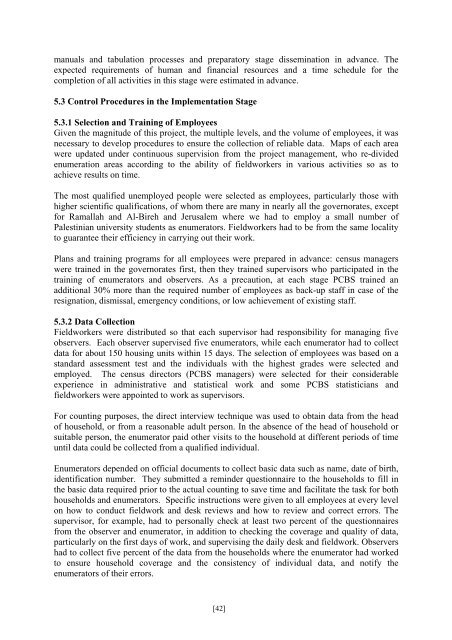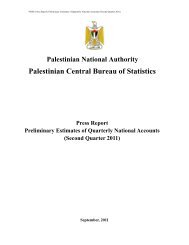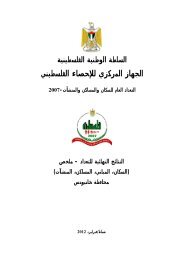اÙÙتائج اÙÙÙائÙØ© ÙÙتعداد ÙÙ Ùطاع غزة Ù Ùخص - Palestinian Central ...
اÙÙتائج اÙÙÙائÙØ© ÙÙتعداد ÙÙ Ùطاع غزة Ù Ùخص - Palestinian Central ...
اÙÙتائج اÙÙÙائÙØ© ÙÙتعداد ÙÙ Ùطاع غزة Ù Ùخص - Palestinian Central ...
Create successful ePaper yourself
Turn your PDF publications into a flip-book with our unique Google optimized e-Paper software.
manuals and tabulation processes and preparatory stage dissemination in advance. The<br />
expected requirements of human and financial resources and a time schedule for the<br />
completion of all activities in this stage were estimated in advance.<br />
5.3 Control Procedures in the Implementation Stage<br />
5.3.1 Selection and Training of Employees<br />
Given the magnitude of this project, the multiple levels, and the volume of employees, it was<br />
necessary to develop procedures to ensure the collection of reliable data. Maps of each area<br />
were updated under continuous supervision from the project management, who re-divided<br />
enumeration areas according to the ability of fieldworkers in various activities so as to<br />
achieve results on time.<br />
The most qualified unemployed people were selected as employees, particularly those with<br />
higher scientific qualifications, of whom there are many in nearly all the governorates, except<br />
for Ramallah and Al-Bireh and Jerusalem where we had to employ a small number of<br />
<strong>Palestinian</strong> university students as enumerators. Fieldworkers had to be from the same locality<br />
to guarantee their efficiency in carrying out their work.<br />
Plans and training programs for all employees were prepared in advance: census managers<br />
were trained in the governorates first, then they trained supervisors who participated in the<br />
training of enumerators and observers. As a precaution, at each stage PCBS trained an<br />
additional 30% more than the required number of employees as back-up staff in case of the<br />
resignation, dismissal, emergency conditions, or low achievement of existing staff.<br />
5.3.2 Data Collection<br />
Fieldworkers were distributed so that each supervisor had responsibility for managing five<br />
observers. Each observer supervised five enumerators, while each enumerator had to collect<br />
data for about 150 housing units within 15 days. The selection of employees was based on a<br />
standard assessment test and the individuals with the highest grades were selected and<br />
employed. The census directors (PCBS managers) were selected for their considerable<br />
experience in administrative and statistical work and some PCBS statisticians and<br />
fieldworkers were appointed to work as supervisors.<br />
For counting purposes, the direct interview technique was used to obtain data from the head<br />
of household, or from a reasonable adult person. In the absence of the head of household or<br />
suitable person, the enumerator paid other visits to the household at different periods of time<br />
until data could be collected from a qualified individual.<br />
Enumerators depended on official documents to collect basic data such as name, date of birth,<br />
identification number. They submitted a reminder questionnaire to the households to fill in<br />
the basic data required prior to the actual counting to save time and facilitate the task for both<br />
households and enumerators. Specific instructions were given to all employees at every level<br />
on how to conduct fieldwork and desk reviews and how to review and correct errors. The<br />
supervisor, for example, had to personally check at least two percent of the questionnaires<br />
from the observer and enumerator, in addition to checking the coverage and quality of data,<br />
particularly on the first days of work, and supervising the daily desk and fieldwork. Observers<br />
had to collect five percent of the data from the households where the enumerator had worked<br />
to ensure household coverage and the consistency of individual data, and notify the<br />
enumerators of their errors.<br />
[42]
















